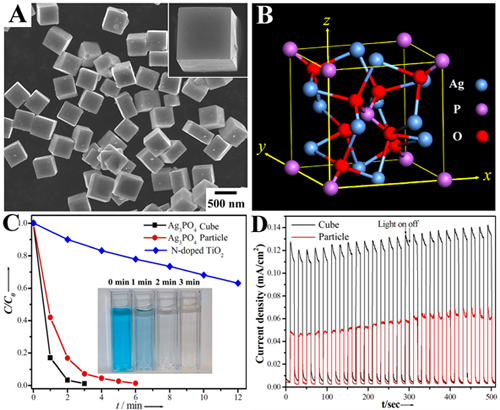Semiconductor photocatalysis has been considered to be a potentially promising approach to solve energy and environment problems with abundant solar light. However, the semiconductor materials available are generally limited by either poor photocatalytic efficiency in the visible light range or insufficient charge separation ability.
The energy and nano catalytic materials for environment research group at the Lanzhou Institute of Chemical Physics (LICP) of the Chinese Academy of Sciences (CAS) have developed a facile and efficient process for fabricating uniform and perfect Ag3PO4 sub-microcubes with sharp corners, edges, and smooth surfaces at room temperature. Using [Ag(NH3)2]+ precursors, researchers have fabricated the single-crystalline Ag3PO4 sub-microcubes through controlling the release rate of Ag+. The morphology, facet and structure of the Ag3PO4 sub-microcubes can be further tuned by changing the ratio of Ag+ to NH3 in [Ag(NH3)2]+.
 |
| SEM images(A), crystal model(B) , photocatalytic activities(C) and photoelectric conversion performances (D) of the obtained Ag3PO4sub-microcubes.(Image by BI Yingpu et al.) |
The Ag3PO4 cubic crystals exhibit much higher catalytic activities and photoelectric properties than spherical particles for the organic contaminants degradation and photoelectric conversion under visible-light irradiation, which may be due to their novel cubic structure and exposed {100} facets.
Theoretical calculations confirm the metal-like electronic properties of atomic configurations of Ag3PO4 {100} planes, which might promote the harvesting efficiency of the visible-light charge and enhance the photocatalytic activities and photoelectric conversion performances.
The work has received support from the Chinese Academy of Sciences. The findings have been published in Chemical Communications (Chem. Commun., 2012, 48, 3748–3750).
Abstract of the paper published inChemical Communications
